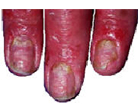Psoriasis in finger & toe nails (Psoriatic nails )

About 50 percent of persons with active psoriasis have psoriatic changes in fingernails and/or toenails. In some instances psoriasis may occur only in the nails and nowhere else on the body. Psoriatic changes in nails range from mild to severe, generally reflecting the extent of psoriatic involvement of the nail plate, nail matrix (tissue from which the nail grows), nail bed (tissue under the nail), and skin at the base of the nail. Damage to the nail bed by the pustular psoriasis can result in loss of the nail.
Nail changes in psoriasis fall into general categories that may occur singly or all together:
The nail plate is deeply pitted, probably due to defects in nail growth caused by psoriasis.
The nail has a yellow to yellow-pink discoloration, probably due to psoriatic involvement of the nail bed.
White areas appear under the nail plate. These are air bubbles marking spots where the nail plate is becoming detached from the nail bed (onycholysis). There may be reddened skin around the nail.
The nail plate crumbles in yellowish patches (onychodystrophy), probably due to psoriatic involvement in the nail matrix.
TThe nail is entirely lost due to psoriatic involvement of the nail matrix and nail bed.
Pustular psoriasis on toenails and foot.
Psoriasis of the nails can resemble other conditions such as chronic infection or inflammation of the nail bed or nail fold. Psoriasis of the toenails can resemble chronic fungal infection of the nails.
A person with psoriatic nails should avoid any injury - bumps, scrapes, etc. - that may trigger a worsening of psoriasis (Koebner s phenomenon). Nail psoriasis is treated by the dermatologist as part of the overall treatment of the disease.
NNail psoriasis is frequently associated with psoriatic arthritiswhich is discussed below.
Psoriatic Arthritis
Psoriatic arthritis is a genetically determined autoimmune disease that occurs in less than 10 percent of persons with psoriasis. Its treatment often requires consultation with a rheumatologist in addition to treatment of the skin lesions by a dermatologist. Psoriatic arthritis is classified with the disease grouping called seronegative spondyloarthropathies which also includes ankylosing spondylitis, enteropathic arthritis, and Reiter s Syndrome. It occurs most frequently in psoriasis patients whose disease is active, especially in persons with the pustular type of psoriasis. Occasionally it appears in a person who has no dermatologic signs or symptoms of psoriasis, in which case it must be diagnosed by its unique laboratory test results. Psoriasis of the fingernails and toenails is associated with a higher incidence of psoriatic arthritis.
Symptoms of psoriatic arthritis resemble those of rheumatoid arthritis, although the diseases are otherwise quite different. Arthritis changes cause deterioration and pain in small joints of the hands and feet, large joints of the legs and spine, and tendons. Nonspecific foot pain or "tennis elbow" may be an early symptom to appear and may be overlooked if not associated with psoriatic skin or nail lesions.
Confirmation of a diagnosis of psoriatic arthritis requires specific blood and serum tests to differentiate it from conditions such as rheumatoid arthritis and other autoimmune diseases.
Please see the National Psoriasis Foundation for information on the treatment of psoriatic arthritis.
A Pediatric form of psoriatic arthritis may appear as early as age 2 to 4 years in girls. A peak period of
Pediatric onset is age 11 to 12 in both girls and boys. In children the arthritis may appear several years prior to the onset of psoriatic skin lesions; this may pose a problem in recognizing the nature of the underlying disease, especially if there is no known family history of psoriasis.
Although psoriatic arthritis and psoriasis occasionally occur in the absence of a history of psoriasis in the family, a genetic predisposition for psoriasis is considered to be a necessary condition for development of psoriatic arthritis. The evidence for inheritability is well established.
As in the case of psoriasis, an environmental "trigger" may initiate the development of psoriatic arthritis in a genetically predisposed person.
Source: Psoriasis Net
Although they can appear anywhere, these patches -- called plaques -- are most likely to crop up on your knees, elbows, hands, feet, scalp, or back. According to the American Academy of Dermatology, the fingernails and toenails are also affected in about 50% of cases.
products for the treatment of psoriasis
We offer a variety of products for treatment of psoriasis. Please click here to see all products or here for the
Dermaray UV treatment comb. |